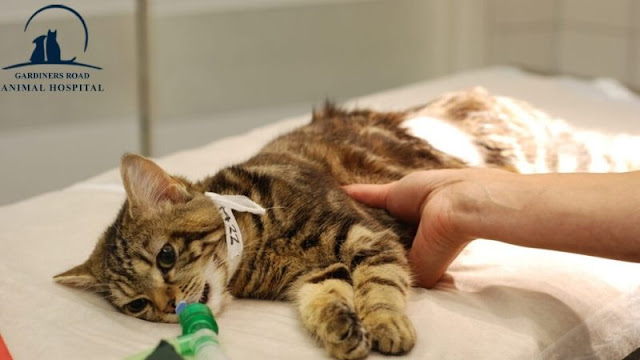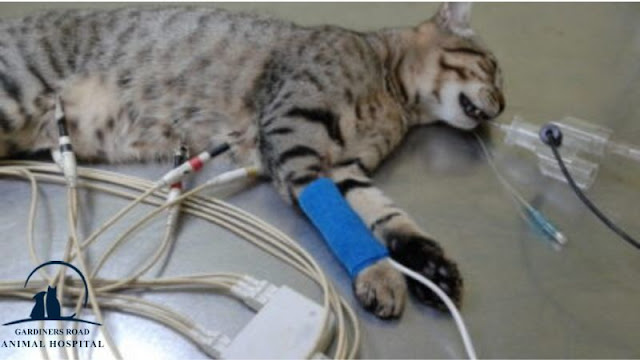An overview of Pet surgery and Anesthesia services at GRAH
The word anesthesia comes from the Greek meaning "lack of sensation". Anesthesia is accomplished by administering drugs that depress nerve function. With general anesthesia, the patient is made unconscious for a short period. During this insensible state, there is muscular relaxation and a complete loss of pain sensation. Other categories of anesthesia include local anesthesia such as numbing a contained area of skin or a tooth, and spinal anesthesia, such as an epidural block, that results in anesthesia of a particular part of the body.
At Grah Kingston, we are providing quality Cat & Dog Surgery and Anesthesia Services. We are known as
one of the best dog & cat Surgery and Anesthesia vet clinics in Kingston.
What are the risks of anesthesia?
There is always a risk of an opposing reaction when we use
any anesthetic agent, no matter whether it is for minor, short-term sedation or
complete general anesthesia lasting several hours. It is generally estimated
that approximately 1 in 100,000 animals will have some sort of reaction to an
anesthetic agent. These reactions may range from slight swelling at the site of
injection or a mild decrease in cardiac output, to a full-blown incident of
anaphylactic shock or death.
Another possible danger associated with anesthesia arises if
the cat is not properly fasted before anesthesia. Anesthetized patients lose
the normal reflex capability to swallow; during swallowing, the epiglottis, a
cartilage flap that closes over the entrance to the windpipe, avoids food or
water from entering the lungs. If there is food in the stomach, the cat could
vomit while under anesthesia or in the early post-anesthetic dated.
If vomiting occurs before the swallowing reflex occurs, the
vomited material can be aspirated or enter into the lungs, causing aspiration
pneumonia, a potentially life-threatening condition. Other rare difficulties of
anesthesia include organ system failures such as kidney liver or heart failure,
visual injury, clotting disorders, and seizures. Every precaution will be taken
to minimize these risks when anesthesia is a necessary part of treatment.
What can be done to minimize the risks?
Pre-surgical physical examination, preoperative blood, and
urine tests, and radiographic examination may reveal clinical or sub-clinical
problems. Certain medical situations will increase the risk of having an
anesthetic complication. These conditions include heart, liver or kidney
disease, diabetes mellitus, anemia, dehydration, and certain infectious
diseases such as heartworm disease. Blood tests will rise the chance of
detecting a hidden problem that could prove to be life-threatening. In older
animals, chest radiographs and electrocardiogram (ECG) are often
recommended to ensure there is no pre-existing pathology in the heart or lungs
that might increase the risk of an adverse reaction.
Immediate intravenous access for emergency drug
administration is one of the most important factors in the successful treatment
of cardiovascular or respiratory letdown in either the conscious or the
anesthetized patient. By placing an intravenous (IV) catheter and line before
anesthesia, your veterinarian can ensure that this lifeline is already in
place, should the necessity arise. Anesthetics, fluids, and emergency drugs can
be managed through the IV line.
Intravenous fluids help sustain blood force in the
anesthetized patient and will change lost fluids (during surgery, fluids are
lost through evaporation from body cavity surfaces, through bleeding, and in
any tissues that are being removed). Upon accomplishment of the process,
intravenous fluid therapy speeds the recovery procedure by diluting the
anesthetic agents circulating in the bloodstream and by improving their
metabolism and elimination through the liver and kidneys.
Patients that receive IV fluid therapy generally wake up quicker than those that do not. Moreover, studies have shown that 0.9 - 2% of all patients that receive general anesthesia will grow kidney dysfunction or failure 7-14 days after anesthesia. This risk is significantly reduced in patients that obtain peri-operative intravenous fluid therapy. Although 98% of all pets will have no problem, your veterinarian's goal is to remove that unknown 2%. For these reasons, all general anesthesia patients should receive intravenous catheterization and fluid therapy.
You should confirm that your pet's complete medical history
is available to your veterinarian, particularly if your pet has been seen at another
veterinary clinic. Earlier anesthetizing your cat, your veterinarian wants
to know about any medications or supplements that your cat has received in the
past few weeks, any pre-existing medical conditions, any known drug reactions,
the results of previous diagnostic tests, and whether the cat has undergone any
anesthetic or surgical events in the past. Other useful information includes
the pet's vaccine status and reproductive status (i.e. when was its last estrus
or heat cycle).
Can you describe a
typical anesthesia?
All anesthesia patients are weighed on admission and are
given a thorough pre-anesthetic examination, which includes an examination of
the chest, palpation of the abdomen, and assessment of the gums checking for
hydration status and an indication of good circulatory status. After reviewing
the medical history, additional diagnostics such as blood or urine testing,
blood pressure, electrocardiogram (ECG), or x-rays of the chest or abdomen may
be performed before administration of any anesthetic drugs.
In the mainstream of cases, a technique called 'balanced
anesthesia' is used. With balanced anesthesia, the patient receives a
combination of sedatives and anesthetic agents that is suited to its individual
needs. The most common combination is a pre-anesthetic sedative and analgesic
combination that is administered by injection, followed by an induction agent
that is also administered by injection; the anesthetized state is maintained
with an anesthetic gas mixed with oxygen.
Pet owners are welcome to visit our Animal
Hospital in Kingston. Elective surgery for your pet may become
necessary when it is suffering from a disease or comorbidity that cannot be
treated using topical creams, or medications alone. Any surgical treatment
requires the services of a professional.




